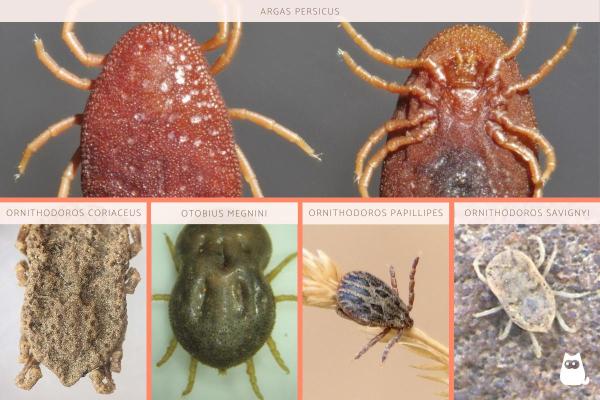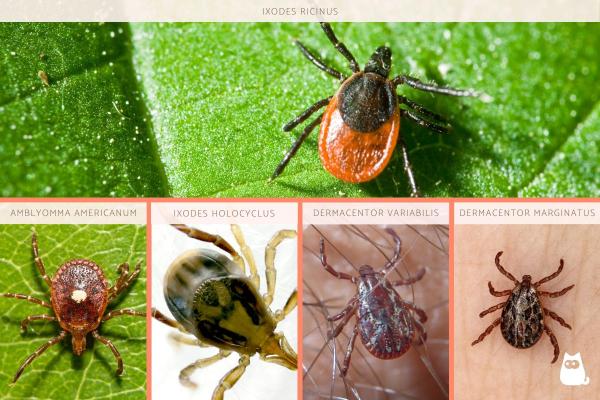
There is increasing awareness of ticks in relation to public health. Much of this is due to the increasing cases of Lyme disease being diagnosed, a condition which can also affect dogs. Ticks are arthropods of the Arachnida class, a category which includes fellow invertebrates such as spiders, scorpions and mites. These are invertebrates which share common features such as having eight jointed legs, but no antennae. While we may be aware of many different types of spiders, many of us still think there are only one type of tick. Ticks actually belong to the superorder Parasitiformes and order Ixodida, with some interesting groupings in terms of type and characteristics.
thedailyECO investigates these groupings by looking at the different types of ticks. We learn about the different tick species we can find and share information about their characteristics, habitats and more.
How many types of ticks are there?
Discerning the exact number of tick species is a difficult task, partly because there are new species still being discovered. Part of the controversy of their taxonomic ranking is their similarity to certain other arachnid species, but there are said to be three main families of ticks:
- Argasidae
- Ixodidae
- Nuttalliellidae
Some of these groups are much more diverse than others, but within all the families of arachnids we know as ticks, we can find over 950 different species. We look at these three groups in more detail below.
Soft ticks (Argasidae)
Of the three families of tick, soft ticks compromise 5 genera with around 212 individual recognized species. The global distribution of this tick family is very wide. Their name refers to their distinctive lack of a scutum, a hard external covering found in other types of ticks. In addition, their mouth parts are located on the lower region of the animal, making them not easily visible to the naked eye. Soft ticks also have a rounded body edge.
The life cycle of these ticks has a greater number of stages than other types of tick. While they have egg and larval stages as with any tick species, they have a varying number of nymphal stages, somewhere between 2 to 5. These occur before the final adult stage. Generally speaking, these parasitical arachnids require a host for feeding and finishing their development outside said host. For this reason, they are one of the most common types of tick on dogs and cats.
It is important to know if your companion animal has a parasite. You can see how to do this with our guide to identifying and eliminating ticks on dogs.
Life cycle of soft ticks
Once swollen from the blood sucked from their host, female soft ticks descend to the ground. They then lay their eggs in hidden spaces, not on the host. A single female can lay between 100 and 500 eggs at a time, with this feeding-reproduction cycle repeated up to six times. After laying the eggs, she can go back to look for another host to parasitize.
There are variations by species, but the general life cycle of soft ticks is as follows:
- Egg hatches as larva
- Larva climbs onto host
- Feeds on host
- Returns to ground as a nymph
- Climbs back onto hos to feed
Some ticks go through several nymphal stages. Between each one, they will climb off and then on again to their host before becoming fully adult. This type of tick parasitizes both people and various animals. They can cause serious health problems, including anemia, inflammation of the affected area, allergic reactions, infections and paralysis, among others.
While they may seem similar, you can learn about the various differences between fleas and ticks in our related article.
Species of sift ticks
Some examples of soft ticks include:
- Pajahuello tick (Ornithodoros coriaceus): parasitizes mammals and animals, rarely humans.
- Fowl tick (Argas persicus): parasitizes mainly birds, but also humans to a lesser extent.
- Relapsing fever tick (Ornithodoros alactagalis): parasitizes people.
- Ornithodoros papillipes: parasitizes people.
- Sinose ear tick (Otobius megnini): parasitizes dogs, horses, cattle, sheep and goats.
- Sand tampan (Ornithodoros savignyi): parasitizes people, domestic and wild animals.

Hard ticks (Ixodidae)
Commonly known as hard ticks, ticks in the family Ixodidae comprise the most diverse and largest group of ticks. They contain 14 genera and around 740 species. At least half of the species in this group are found in the Americas, including the Caribbean. Other hard tick species can be found in sub-Saharan Africa, Asia and Australia. Due to changes in climate change, the distribution of certain species of ticks has been altered, expanding their range and resulting in various health problems.
These types of ticks are important parasites of both people and animals. They mainly parasitize domestic animals and livestock, but they do also affect wild animals. They are vectors of various bacteria, viruses and protozoa that cause serious health problems.
Hard ticks are so-called due to the presence of a scutum, a sclerotized covering on the body. During both the nymphal and adult phases, they have a prominent mouth and feeding structures that project forward from the invertebrate.
Ticks are a common parasite in domestic animals. You can learn about them and other types with our guide to the different parasites of dogs.
Life cycle of hard ticks
The life cycle of ticks in the family Ixodidae is usually the same for most species, characterized by the female feeding on the host's blood until it reaches about 100 times its weight. After this time, fertilization usually occurs on the host, although fertilization occurs on the ground in some species. The female descends from the host to lay eggs, usually laying between 1,500 and 16,000 eggs, sometimes more. This entire process occurs over several weeks, at the end of which period the female dies.
In warm areas, the larvae emerge from the eggs within a few days. In cold environments, they can take months to hatch. Once hatched, the larvae find a host to feed before descending to the ground for nymph transformation. Unlike soft ticks, there is only one nymphal stage, after which they return to the host and become adults. The number of eggs they grow per clutch is also much higher.
Within the various species of hard ticks, we find many that cause significant health problems in their hosts. This is because the saliva of the females is usually toxic. Their bites can result in ascending paralysis, as well as transmit Lyme disease, babesiosis, ehrlichiosis, spotted fever or anaplasmosis, among many others. Find out more with our guide to how to get a tick off a dog.
Species of hard ticks
Some examples of hard ticks include:
- American dog tick (Dermacentor variabilis): primarily parasitizes humans and dogs.
- Australian paralysis tick (Ixodes holocyclus): parasitizes humans and domestic animals.
- Asian tortoise tick (Amblyomma clypeolatum): mainly parasitizes tortoises, dogs and buffalo.
- Lone star tick (Amblyomma americanum): parasitizes people and pets.
- Winter tick (Dermacentor albipictus): parasitizes various types of deer, such as elk, deer or caribou, among others.
- Sheep tick (Dermacentor marginatus): parasitizes humans, pets, sheep and cows, among others.
- Western black-legged tick (Ixodes pacificus): parasitizes mainly lizards and small mammals, but very rarely affects humans.
- Castor bean tick (Ixodes ricinus): parasitizes humans, pets, cattle and sheep.

Nuttalliellidae
In this family of ticks there is only one genus and one species Nuttalliella namaqua. Members of this species inhabit southern Africa, in countries such as Tanzania, Namibia and South Africa. This species is the oldest of the extant tick types and is considered a missing link between soft and hard ticks.
It is characterized by having sclerotized plates on its body, as well as no setae on their legs and other appendages. Its mouthparts are located apically and it has very few denticles in the hypostome (long mouth part). In this way, it presents certain characteristics present in the both of the other two tick families.
Exact data on the biology of N. namaqua are unknown. This means there are few details about its life cycle. However, it has been possible to identify the fact they mainly parasitizes lizards and, to a lesser extent, birds and mammals. It has been reported as a generalist in terms of host. There are no reports indicating that this species carries vectors that cause health problems.
Now you know the different types of ticks that exist, you should know that different tick species will present varying levels of threat. Learn more about the dangers ticks pose with our article on whether dogs can die from ticks.


If you want to read similar articles to Different types of Ticks - Tick Species, we recommend you visit our Facts about the animal kingdom category.
- ITIS (2023). Ixodoidea. Retrieved from: https://www.itis.gov/servlet/SingleRpt/SingleRpt?search_topic=TSN&search_value=1117897
- Estrada, A. (2015). Order Ixodida: Ticks. Retrieved form: http://sea-entomologia.org/IDE@/revista_13.pdf
- Science Direct. (2017). Argasids. Retrieved from: https://www.sciencedirect.com/topics/agricultural-and-biological-sciences/argasidae
- Mans, B. J., deKlerk, D., Pienaar, R., & Latif, A. A. (2011). Nuttalliella namaqua: a living fossil and closest relative to the ancestral tick lineage: implications for the evolution of blood-feeding in ticks. PloS one, 6 (8), e23675. Retrieved from: https://doi.org/10.1371/journal.pone.0023675